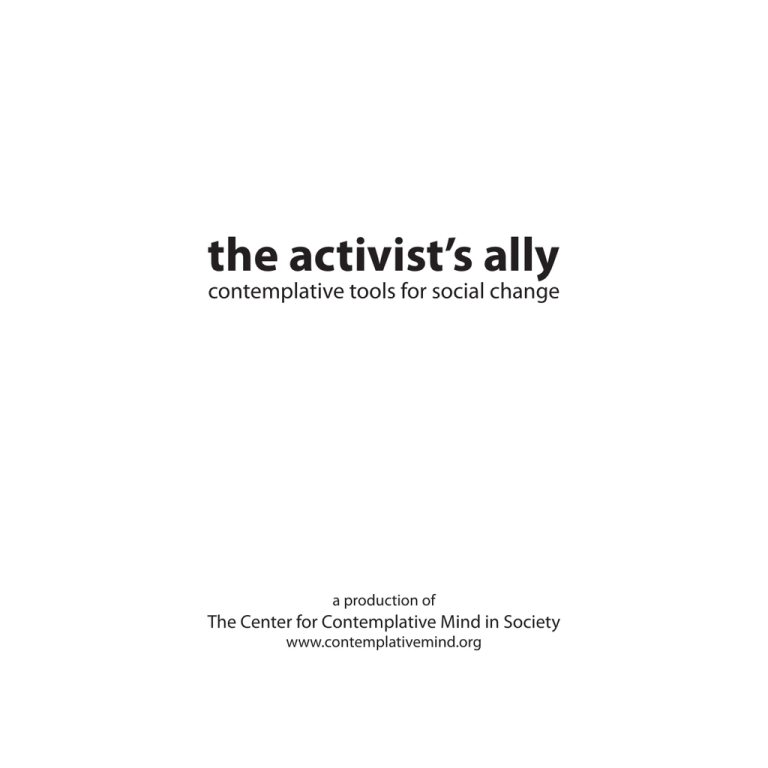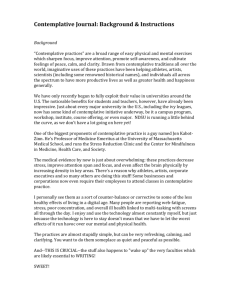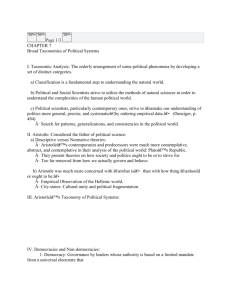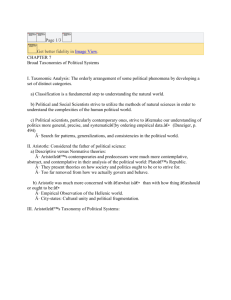the activist’s ally contemplative tools for social change a production of
advertisement

the activist’s ally contemplative tools for social change a production of The Center for Contemplative Mind in Society www.contemplativemind.org © 2007, 2011 The Center for Contemplative Mind in Society Produced and published by The Center for Contemplative Mind in Society PO Box 817 Northampton, MA 01061 www.contemplativemind.org Many people worked together to create this guide: Writing: Dan Edwards Mirabai Bush Jesse Maceo Vega-Frey Maia Duerr Claudia Horwitz Rose Sackey-Milligan Carrie Bergman Photos: Dan Edwards Mirabai Bush Jennifer Akey Sophia Awad Rice Carrie Bergman Chapter Illustrations: Deborah Koff-Chapin from SoulCards 1 & 2 www.touchdrawing.com Other Illustrations: Carrie Bergman Funding was provided by the Ford Foundation, the Fetzer Institute, and the Nathan Cummings Foundation. Special thanks to Francesca Barajas for her invaluable consultation, Deborah Koff-Chapin (www.touchdrawing.com) for allowing us to use her beautiful artwork, and to Sounds True, Sule Greg Wilson, Jai Uttal, Chivonnie Meekins, and Ian Koebner for allowing us the use of their words and music on the Companion CD. Contents Part I: An Introduction to Contemplative Practice 1 What Are Contemplative Practices?.................................1 2 Compassionate Justice: Contemplative Skills.................5 and the Social Justice Movement 3 Starting and Sustaining a Contemplative Practice........11 The Tree of Practices...........................................................................12 Creating Practices from Your Ancestral Traditions...................14 Choosing an Existing Practice.........................................................16 Sustaining Your Practice...................................................................39 4 Shifting Perspectives........................................................43 Dealing with Anger.............................................................................45 Part II: Contemplative Groups and Organizations 5 Creating Contemplative Groups and Organizations......49 Meetings.................................................................................................52 Conference Calls..................................................................................59 Facilitation.............................................................................................61 Conflict Resolution.............................................................................71 Staff Retreats.........................................................................................76 Table of Inspiration..............................................................89 Outcomes...............................................................................................94 6 Bravehearts........................................................................97 7 Resources...........................................................................105 The Companion CD At the back of this book you will find a CD of practice instructions, stories and music. We would like to thank all the wonderful beings who have contributed to this compilation. Look for this symbol throughout the book: CD It appears next to topics that are supplemented by content on the CD. Companion CD Track Listing 1. Welcome to the Path Eyerate and Dinoswords Companion CD Original, 2006 2. Kaira Silo/The Hand of Love Sule Greg Wilson The Drummers’ Path Destiny Recordings, 1994 3. Basic Meditation/Counting the Way Ian Koebner Companion CD Original, 2006 4. Loving-Kindness Meditation Mirabai Bush Companion CD Original, 2006 5. Oriki Egún/Praising the Ancestors Rose Sackey-Milligan Companion CD Original, 2006 6. Ritual Sobonfu Some Women’s Wisdom from the Heart of Africa Sounds True, 2005 7. Introduction to Kirtan Dan Edwards Companion CD Original, 2006 (Kirtan from Sita Ram by Jai Uttal) 8. Sita Ram Jai Uttal Kirtan! The art and practice of ecstatic chant Sounds True, 2004 9. Like This Coleman Barks I Want Burning: The Ecstatic World of Rumi, Hafiz, and Lallah Sounds True, 2001 10. The Way of the Drummer Sule Greg Wilson Companion CD Original, 2006 11. The Opening of the Way Sule Greg Wilson The Drummers’ Path Destiny Recordings, 1994 12. Soul Dancing Chivonnie Meekins Companion CD Original, 2006 Drums from The Drummers’ Path, 1994 13. Del MeeravadZe Dastam (My Heart is Slipping from My Grasp) Dashtan Ensemble Sounds True, 2000 Welcome The Activist’s Ally is a resource manual for social justice activists seeking to bring contemplative practices into their lives, communities and workplaces. This manual is designed to assist you down the road of personal transformation with a dual focus on individual and group practice. As you read through each chapter, reflect on your own state to see how you personally connect with the material. Then, see how the information can affect your immediate community. The work begins with you. We have to develop some form of sustaining practice if we intend to stay in the fight for justice over the long haul. At the Center for Contemplative Mind in Society, we’ve learned that burnout is a growing trend in the social justice community and one of the most difficult challenges we confront. We believe that the best way to sustain ourselves while working for change is with the help of contemplative practices: activities that, when incorporated into our daily life, bring us strength, peace, and inspiration. We hope that this manual will serve as an introduction to contemplative social justice work, a companion to steady the ship during rough travels. The Center for Contemplative Mind in Society’s goal is to bring contemplative practice to people who are working to improve our world. This manual grew from ten years of the Center’s work with various organizations that have worked for social justice on issues including civil rights, equal rights, environmental justice, economic justice, welfare and poverty, education and the arts, health care including AIDS/HIV, labor, criminal justice, free speech and media reform, immigration, and housing and homelessness. Many of us have suffered burnout, and even when we are part of a contemplative workplace and individually nurture our paths of practice, we are still susceptible to being overworked and pushing too hard. However, our individual and organizational systems and practices help us to foster a greater awareness of when burnout is taking place and thus slow down, reflect, and pursue self-care. We understand and have fought this struggle, and it is our mission to pass on the tools that have been most beneficial during our campaigns. These are the gifts that we want to share with you. What is the Center for Contemplative Mind in Society? The Center began in 1993 when a group of people with experience in contemplative practice and an interest in social change came together to explore how contemplative practice could support work for social transformation. In 1997, the Center for Contemplative Mind in Society was incorporated as a non-profit organization with a mission to integrate contemplative awareness into contemporary life in order to help create a more just, compassionate, and reflective society. Because the Center wanted to make contemplative practices available in ways other than traditional monastic forms, we began by offering programs of practice and discussion to people who shared a common profession or interest. We originally created pilot projects in philanthropy, business, law, environment, journalism, higher education, and social justice activism to engage people in both the personal and professional concerns of their lives. In 2010, we focused our efforts on improving post-secondary education. We now hold conferences, retreats and workshops, create publications, identify useful resources, and connect likeminded individuals and organizations to help promote a stronger network of people working to improve education, and our society, with contemplative practices. Part I: An Introduction to Contemplative Practice 1 What Are Contemplative Practices? What are contemplative practices? Most people don’t know what contemplative practices are, and there are language differences that keep us from understanding their essence and meaning. In other words, you may already have a contemplative practice in your life, but you may call it by a different name. At the Center, we use the phrase “contemplative practice” to refer to any activity undertaken regularly with the intention of quieting the mind and cultivating deep concentration, calm, and awareness of the present moment. These practices can help develop compassion and an awareness of the interconnectedness of all life. Ideally, the insights that arise from the mind, body, and heart in the contemplative state reveal what has meaning in our lives. Contemplative practices can include many forms of single-minded concentration, such as meditation; journal writing; mindful movement such as yoga, t’ai chi, and dance; prayer; mindful reading; experiences in nature; artistic practices such as poetry, music, and spoken word; and forms of social activism in a context of mindfulness. These practices may be done in silence and solitude, but they may also take a communal form. We consider various kinds of rituals and ceremonies, such as those designed to create sacred space, mark rites of passage, and celebrate cyclical nature of time, to be forms of contemplative practice. These include the practice of Shabbat, seasonal celebrations, fasting, and vision quests. We also view engaged interpersonal communication as a form of contemplative practice, including the Native American council circle process, storytelling, dialog, and deep listening. Through the thoughtful application of the effects of contemplative practice to your daily life, a contemplative perspective gradually develops. The contemplative perspective connects the increased inner sensitivity that practice brings with your activity in the outer world, through your work and relationships. By becoming 1 2 Compassionate Justice: Contemplative Skills and the Social Justice Movement In the world of service today, it is normal to “do, do, do” and keep doing until the job is done, regardless of what it takes. This form of service, although courageous, can wipe us out as we focus all of our energy toward the well-being of others while being unaware of the implications for our own health and safety. Transforming Activism Although the connection between inner peace and a just world is known by many, the culture of social justice organizing and activism has severely undermined the physical, mental, emotional, and spiritual health of some of its finest warriors. This is a culture that encourages you to push yourself beyond reasonable limits because often there are no measures to determine when you have worked hard enough. Leaders may encourage an unhealthy and unrealistic work ethic. Burnout is often interpreted as a personal failure. Activists often work from a place of righteousness and excessive anger, losing perspective of the long view of change and possibly replicating one system of injustice with another. Contemplative awareness can serve as a countermeasure to these challenges. Compassionate justice is not only about self-care. It is also about helping you work to transform injustice into justice. With contemplative practices and self-care, it becomes easier to keep from adopting the language and methods of our adversaries. One of the beautiful things about integrating a contemplative perspective into your work is the joy of watching yourself shift from fighting fire with fire to fighting fire with water. 5 6 Creating Contemplative Groups and Organizations What is a Contemplative Organization? Contemplative organizations use contemplative practices in the services they offer, but also as an organizing principle for the workplace. Contemplative organizations strive to incorporate contemplative practices into all aspects of their work. The work day is specifically structured to offer opportunities for staff to practice, both alone and together. These opportunities could include: • Beginning meetings with silence • Use of reflective dialogue in meetings • Permission to take “contemplative breaks” during the day • Creation of special space in the office for prayer, meditation, and/or quiet • Use of contemplative group techniques like Appreciative Inquiry and Council Circle to conduct strategic planning for the organization • Scheduling regular contemplative staff retreats as a source of unity and inspiration. 49 Contemplative organizations share the following characteristics: • Embodying Values The organization models, as best it can, the changes it wishes to see in society. The mission, vision, and strategic plan emphasize the importance of the organization’s core values. • Moving Between Cycles of Action and Reflection The organization recognizes that there is a time to work and a time to step back, rest, and learn from the past in order to plan for the future. • Balancing Process With Product The way in which the organization works toward its goal is as important as the achievement of the goal. • Fostering a Workplace Culture of Caring and Respect Leadership and personnel policies demonstrate compassion and respect towards employees and volunteers. Co-workers acknowledge and support each others’ strengths. Challenges Creating a contemplative organization can be a challenging proposition. At the core, helping the general public, funders, activists and organizers understand the nature of contemplative practice and the qualitative difference in the impact of the work done from this approach requires time and patience. They must experience it to appreciate it. Some activists who value contemplative practice see it as extraneous to their “real work,” which is organizing in communities and dealing with suffering; anything other than that is not valued. We have heard social justice workers say, “We don’t have time for this,” and “We just need to get the work done.” Similarly, community organizations are usually operating in organizational structures that undervalue the essential elements of contemplative awareness: slowing down, quieting the mind, introspection, and not always taking action. Moreover, there is common belief in the social justice movement that religion and spirituality and one’s professional life should occupy different “compartments.” For others there is outright resistance and suspicion. Some think of contemplative practices as too spiritual, religious, strange, or as something reserved for only those leading a monastic life. A further challenge is finding funding sources to support the development of contemplative organizations. Contemplative organizations are not yet widely understood in the foundation world, and funders may not consider the integration of these practices into social justice work as an activity eligible for funding. It is our hope, despite these challenges, that you and your organization attempt the following suggestions with an open heart and mind. 51 Staff Retreat Day Focus: The Table of Inspiration A Table of Inspiration is a wonderful addition to life in organizations. The Table of Inspiration creates and develops what might be called a “center of gravity” for your workplace: a place where the community finds its center and communal grounding. These kinds of places are an important factor in any kind of community, whether formal or informal. People always find a place and a way to congregate: to share from a deeper place and find community support. Barbershops, parks, and cafés are good examples of community places that serve as centers of gravity. While these places may rise and fall away spontaneously, the intention of creating such a center can have longlasting benefits. Where are the in-between spaces in your workplace? Is there a kitchen, hallway, water fountain, or copy machine where people naturally converge? A place where the unofficial conversations happen around work or non-work related themes? These spaces are too often thought of as places where productivity slips and concentration is lost. Often, organizations discourage the use of these spaces. However, it may be more helpful to try and use those spaces productively. A Table of Inspiration can be used to collect and concentrate energy in ways that promote work, rather than detract from it. Maybe it makes sense to situate the Table in or around one of these natural centers of gravity, or maybe not. Maybe you have a space in your office that seems like it could be a central location, if some intention were put behind it. Maybe the Table is not a permanent fixture in your office, and is used only at regular intervals or celebrations throughout the year. Regardless of how you choose to incorporate the model into your organization, it can be a powerful method of staff development and community building. The Table of Inspiration can be used to learn about each other in new and profound ways through sharing stories, symbols, and people that are meaningful to us. It encourages modes of communication that are not typical in the workplace. 89 If you decide to set up a Table, regular attention will keep it alive. During staff meetings, you may want to set aside time for making additions to it and to comment on anything previously added. Your office may choose to come up with themes for the Table related to the time of year, holidays, current events, or periods of historical relevance. This can help to keep it fresh. On the other hand, it can also create disruption if people feel attached to the continuity of certain elements in the Table: this can be a place of exploration for you and your co-workers. Either way it can be helpful to have elements of ritual or ceremony in the changing and maintenance of the Table of Inspiration, so that everyone feels involved in the ongoing process. It doesn’t have to be a big to-do, but changes should be made with some level of public recognition. What should be placed there? Nothing is objectively prohibited, but it should be used as a “sacred space.” However, the definition of “sacred” can vary from day to day and from person to person. Whatever is considered meaningful should be valid. For many people, humor is sacred. For others, religion. The commitment to having a space that is open to all forms of sacredness, even its most mundane or playful forms, can be a challenging, but fascinating, experiment. Items that are funny, poignant, powerful, inspiring, silly, sad, or controversial can all be helpful, as long as people learn to relate to it in an open and spacious way. 90 If something is placed on the Table of Inspiration that people find offensive or troubling, this should be seen as an opportunity for dialog and discussion in your office. Maybe your coworkers would be interested in setting up some ground rules or protocol around use and development of the Table. Having intentional forms for dealing with conflict helps prevent organizational trauma and guides the organization on a path toward learning. Here are some ideas for building your workplace Table of Inspiration: • Many altars include the four elements of fire, earth, water, and air in material or symbolic form. Also, something alluding to the six directions of north, east, west, south, above, and below is common. These elements help create an understanding of the broader, universal context in which these offerings exist: reminding us of where we come from, what we ultimately depend on, and in what direction we are headed. • Photos of inspiring people related to your work can be a powerful way of reconnecting with deeper intentions and motivations. Constituents, leaders in the field, and historical personalities can help us ground ourselves in the rationale and inspiration for our work. • Cloth, ribbons, candles, and other decorations can help make the Table more compelling and beautiful. • Musical instruments. Natural things. Unnatural things. Trinkets. • Things representing the past, present, and future. A Seasonal Offering Ceremony One way of integrating the Table of Inspiration into your office is for the staff to formally revisit it at the beginning of each season to set the tone and provide a base of reflection for the period ahead. Spend some time collectively dismantling the last season’s altar. If it feels appropriate, it may be powerful to do this in silence, with individuals reflecting on the objects they are removing from the altar. Some potential questions to keep in mind may be: How have these offerings guided you through the past four months? Have they provided 91




